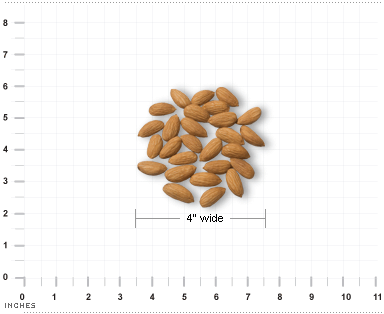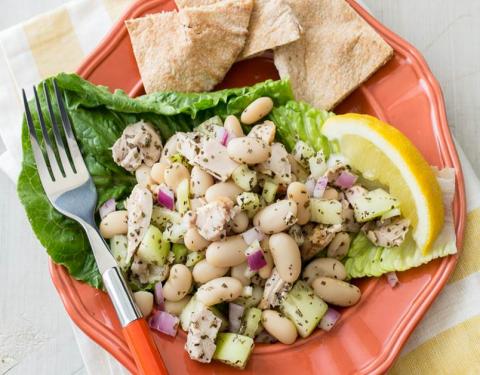Go LEAN with Protein
Go LEAN with Protein
by Katie Cullum
I was pleasantly surprised by the grocery store panic rush. Some of the first things that was sold out were dry beans! Wonder why? I also noticed that fresh and frozen meat & poultry were almost gone, but there were still plenty of canned beans. Getting enough protein was obviously a concern for a lot of people! Most Americans get plenty of protein, but how much is enough?
That depends on your age, sex, and activity level but most people need between 2 and 6 ½ ounce-equivalents each day. So how much is that?
1-ounce equivalents = 1 ounce of meat, poultry, or fish; ¼ cup cooked beans; 1 egg; 1 tablespoon of peanut butter; or ½ ounce of nuts or seeds.

1 ounce almonds (about 25) counts as 2 ounce-equivalents in the Protein Foods Group
A woman between 31-50 that gets less than 30 minutes per day of moderate physical activity needs 5 ounce equivalents of protein. That could include an egg at breakfast, ¼ cup cooked beans at lunch, and a 3-ounce serving of chicken at dinner. If that women got more activity, she would need more. Notice that what a person needs is different from a person may want! That distinction is important during this time of pandemic and being at home. If you’re not getting as much physical activity, and you’re not running low on supplies, you can probably consume less protein than normal.
The protein group supplies many nutrients such as protein, B vitamins, vitamin E, iron, zinc, and magnesium. But some of our protein choices can also supply some not-so-great things like saturated fat (which can raise your bad/LDL cholesterol) and cholesterol. Some protein choices that are high in saturated fat include fatty cuts of beef, pork, & lamb; 75-85% lean ground beef; regular sausages, hot dogs & bacon; some luncheon meats such as regular bologna and salami; and some poultry such as duck. Limit how much of those foods you eat on a regular basis. Focus more on leaner cuts.
Go LEAN with protein:
- The leanest beef cuts include round steaks and roasts (eye of round, top round, bottom round, round tip), top loin, top sirloin, and chuck shoulder and arm roasts
- The leanest pork choices include pork loin, tenderloin, center loin, and ham.
- Choose lean ground beef. To be considered lean, the product has to be at least 92% lean/8% fat.
- Buy skinless chicken parts, or take off the skin before cooking.
- Boneless skinless chicken breasts and turkey cutlets are the leanest poultry choices.
- Choose lean turkey, roast beef, ham, or low-fat luncheon meats for sandwiches instead
of luncheon/deli meats with more fat, such as regular bologna or salami.

1 small chicken breast half (cooked) counts as 3 ounce-equivalents in the Protein Foods Group
VARY Your Protein Choices:
- Choose seafood at least twice a week as the main protein food. Look for seafood rich
in omega-3 fatty acids, such as salmon, trout, and herring. Some ideas are:
- Salmon steak or filet
- Salmon loaf
- Grilled or baked trout
- Choose beans, peas, or soy products as a main dish or part of a meal often. Some choices
are:

½ cup pinto beans (cooked) counts as 2 ounce-equivalents in the Protein Foods Group
- Chili with kidney or pinto beans
- Stir-fried tofu
- Bean soups
- Garbanzo or kidney beans on a chef’s salad
- Rice & beans
- Hummus on pita bread
- Choose unsalted nuts as a snack, on salads, or in main dishes. Use nuts to replace meat or poultry not in addition to these items:
- Use pine nuts in pesto sauce for pasta
- Add slivered almonds to steamed vegetables
- Add toasted peanuts or cashews to a vegetable stir-fry instead of meat
- Add walnuts or pecans to a green salad instead of cheese or meat
Check the NUTRITION LABEL:
- Look for less of these - saturated fat, trans fat, cholesterol, and sodium
- Processed meats such as hams, sausages, frankfurters, and luncheon/deli meats have added sodium.
- Fresh chicken, turkey, and pork that have been enhanced with salt-containing solution also have added sodium.
- Lower fat versions of many processed meats are available. Look at the labels to choose products with less fat and saturated fat.
Keep it SAFE to eat:
- Separate raw, cooked, and ready-to-eat foods.
- Do NOT wash or rinse meat or poultry (even if the recipe says to!)
- Wash cutting boards, knives, utensils, and counter tops in hot soapy water after preparing each food item and before going on to the next one.
- Store raw meat, poultry, and seafood on the bottom shelf of the refrigerator so juices don’t drip onto other foods.
- Cook foods to a safe temperature to kill microorganisms. Use a meat thermometer, which measures the internal temperature of cooked meat and poultry, to make sure that the meat is cooked all the way through.
- Chill (refrigerate) perishable food promptly and defrost foods properly. Refrigerate or freeze perishables, prepared food and leftovers within two hours.
- Plan ahead to defrost foods. Never defrost food on the kitchen counter at room temperature. Thaw food by placing it in the refrigerator, submerging air-tight packaged food in cold tap water (change water every 30 minutes), or defrosting on a plate in the microwave.
- Avoid raw or partially cooked eggs or foods containing raw eggs and raw or undercooked meat and poultry.

Need a quick & easy recipe made with mostly pantry staples? Here’s a yummy Mediterranean Chicken and White Bean Salad. Feel free to sub out the chicken with tuna and the cucumber with tomatoes (or whatever is handy). This is a really good recipe that will help you get in your protein AND vegetables!